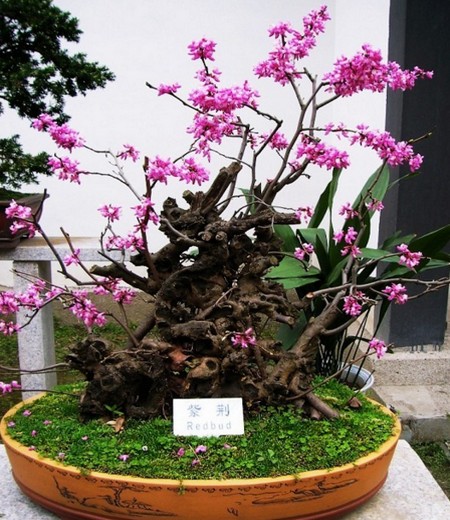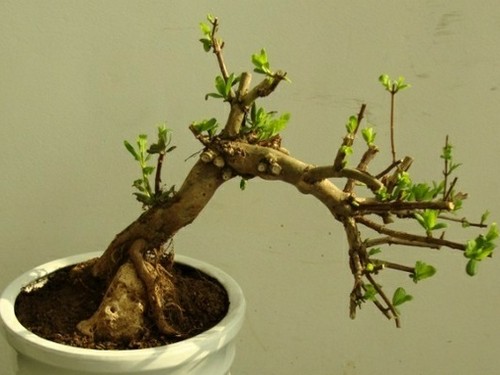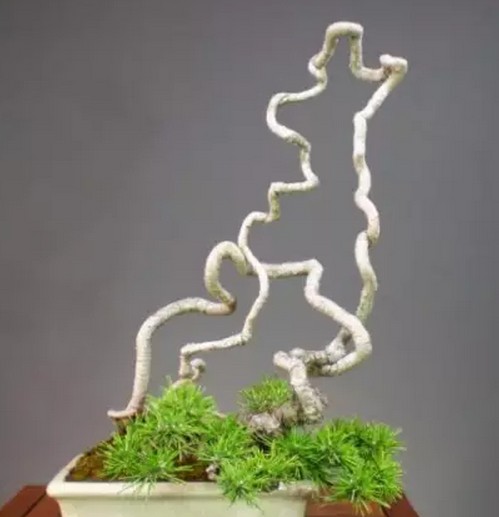Production method of Bauhinia bonsai
Bauhinia its spring purplish red flowers bloom in the first leaves, shaped like butterflies, when in full bloom, close to the branches, the tree is full of flowers, not only on the branches, but also the old trunk, even the trunk close to the root can also bloom. After the defoliation in winter, the branches show their muscles and bones, and the feeling of vigorous Qiu qu is suddenly in front of us. Use it to make bonsai, with quaint and colorful roots, full of flowers in spring, whirling green leaves in summer and autumn, Qiuqiu dry branches in winter, with different viewing points throughout the year, it is a kind of bonsai plant worth popularizing.

Bauhinia genus also has white flower bauhinia, giant bauhinia, Canadian bauhinia, Canadian red leaf bauhinia and other species, as long as the shape is suitable, can also be used to make bonsai.
[source of materials]
Bauhinia can be propagated by sowing, plant division, striping, cutting and other methods. Making bonsai commonly used for many years, strange shape, quaint and vigorous old piles, garden departments in urban expansion, park reconstruction often have eliminated old bauhinia piles, can be collected as materials for bonsai production.
The transplanting of bauhinia is mostly carried out before the leaves are unfolded in spring. When digging, the branches that are not needed in the shape will be cut off, and the overlong main roots should also be cut off, leaving more lateral roots and whisker roots, and first planted in the mud basin or underground to "raise embryos." Before planting, carry out a plastic shape according to the shape and intention of the tree, pour water after planting and keep it in a place away from the wind and the sun, and cover it with a transparent plastic bag to keep warm when the weather is cold. later, pay attention to observation, water should be replenished during drought, but the soil should not be flooded. When the weather is fine, open the plastic bag for ventilation, and finally gradually remove the plastic bag. If the bud appears in the plant during the period of "embryo cultivation", it should be removed in time, so as not to consume too much nutrients due to plant flowering and affect the growth.
[process of putting on the basin]
Select basin: Bauhinia generally choose deeper glazed pottery basin or purple sand pottery basin, square, round and oval are more common, and sometimes shallow rectangular basins are used. The color of the basin is light yellow or cyan, to set off full branches of purplish red flowers.
The use of soil: the demand for soil quality is not high, slightly acidic or slightly alkaline soil can adapt. Potted plants should be cultivated with fertile, loose and permeable rotten leaf soil or Tanghe mud mixed with sandy soil and rice chaff ash.
Planting: usually planted between February and March in spring. When planting, the main root and overlong root system should be truncated, and the branches should be cut short properly, leaving only 3-4-year-old branches as backbone branches.
[orthostatic technique]
Processing: Bauhinia mostly adopts the processing modeling method of shearing as the main and tie as the auxiliary. Generally speaking, it is only necessary to properly climb the main stem into the required posture, and the wire climbing is more convenient and comfortable, and it is better to carry out it in the post-flowering plum rain season. The branch is modeled by pruning combined with climbing, and it is also better to process it after flowering.
Tree shape: Bauhinia bonsai models are mainly oblique dry type, curved dry type, hanging branch type, jungle type and so on. The natural shape is also good, full of purple flowers, very beautiful.
[bonsai modeling]
Using Bauhinia seedlings as materials, it can be processed into different forms of bonsai, such as straight dry type, double dry type, oblique dry type, jungle type and so on. When the young trees grow to the 2cm or so, they can be modeled flat and shaped to make the trunk curved to increase the sense of beauty.
For the old Bauhinia stump which has been growing for many years, it is necessary to make different forms of bonsai according to the specific shape of the stump. Because of its large leaves, the crown should be natural, and bonsai with smaller leaves, such as elm and lobular privet, should not be deliberately tied into clouds to highlight the characteristics of tree species.
The branches of Bauhinia are soft, easy to shape, strong germination and resistant to pruning, so they can be modeled by the combination of flat binding and pruning in the growing season. The old branch should be carefully bent so as not to break it. Because the bauhinia blossoms on the old branches and there are no flowers on the new branches, we should take the old branches as the main body of the crown and pay attention to the direction of the branches so that their distribution is uniform and reasonable. Do not keep too many branches, it is better to be sparse, and do not trim the small branches into dense chicken claws or antlers like other tree species, but present the larger branches on the surface of the crown to prevent the flowers from being obscured by the branchlets during flowering. On the basin can be part of the old root exposed to the soil, so that its hanging roots show claws, Qiu qu ancient.
[daily management]
Bauhinia prefers a warm, humid and sunny environment. Bonsai can be maintained in a place with bright light and good ventilation, even in high temperature in summer. If the light is not enough, the branches will grow and the blossom will be rare.
Watering during the growing period should not be dry or watered thoroughly to avoid stagnant water in the potted soil, especially in the flowering period, so as not to shorten the flowering period because the soil is too wet. Every spring and autumn season, the mature thin liquid fertilizer is applied every 10 days or so, the fertilizer solution is mainly phosphorus and potassium fertilizer, supplemented by nitrogen fertilizer, in order to meet the growth requirements, prolong the flowering period, promote the formation of flower buds, and stop fertilization at high temperature in summer.
After flowering, the plant is shaped, the extra long branches are cut off, and some of the new branches are retained to prepare for flowering the year after next year. If you do not consider viewing the fruit, you can remove the pod when it just grows, so as to avoid consuming too much nutrition and affecting the rejuvenation of the branches. If you want to reward pods, do not remove them, but you can increase the amount of phosphorus and potassium fertilizer to meet the growth needs. Usually, the new branches should be tied up at any time, and the over-long branches should be shrunk in time, and the branches that affect the tree shape should be cut off as soon as possible, so as to maintain the perfection of the tree shape and increase the ventilation and light transmittance of the inner chamber, which is conducive to plant growth. The final pruning was made at the end of autumn to shape the plant.
In winter, move to indoor sunny places or outdoor sunny places to overwinter, and the temperature is maintained at 0 ℃? 10 ℃, if the temperature is too high, the plant will sprout ahead of time, which is disadvantageous to the growth of the second year.
Turn the basin once a year after falling leaves or before blooming in spring, and trim the overlong root system properly when changing the basin, not by hand, because the root bark of Bauhinia is flexible, which will cause large scars, which will affect the growth of the plant. in serious cases, it can also lead to bonsai death. The basin soil should be a slightly acidic sandy soil with loose, fertile and good drainage.
There are not too many diseases and insect pests in Bauhinia, which mainly include diamondback moth, coir moth, beetle, longicorn beetle and so on, which mostly occur in summer and autumn, and can be controlled by omethoate and other pesticides.
Time: 2019-05-26 Click:
- Prev

How to make bonsai of honeysuckle
Honeysuckle is a temperate and subtropical tree species, which is sunny, shade-tolerant, cold-tolerant, drought-tolerant and moisture-tolerant, and can adapt to both acidic and alkaline soil, but likes loose and fertile neutral sandy loam. It has strong nature, developed root system, strong sprouting ability, light plant, graceful posture and elegant old pile.
- Next

The method of making bonsai with root-lifting tree stump
The root is an important part of the stump bonsai. The distribution and shape of the root directly affect the ornamental value of the bonsai. Through planned cultivation, the roots of the stump are turned over, changed soil and changed pots year by year. In this process, the roots are arranged, the extension direction of the roots is mastered, and then they continue to be planted, gradually revealing the soil surface of the roots.
Related
- Fuxing push coffee new agricultural production and marketing class: lack of small-scale processing plants
- Jujube rice field leisure farm deep ploughing Yilan for five years to create a space for organic food and play
- Nongyu Farm-A trial of organic papaya for brave women with advanced technology
- Four points for attention in the prevention and control of diseases and insect pests of edible fungi
- How to add nutrient solution to Edible Fungi
- Is there any good way to control edible fungus mites?
- Open Inoculation Technology of Edible Fungi
- Is there any clever way to use fertilizer for edible fungus in winter?
- What agents are used to kill the pathogens of edible fungi in the mushroom shed?
- Rapid drying of Edible Fungi

